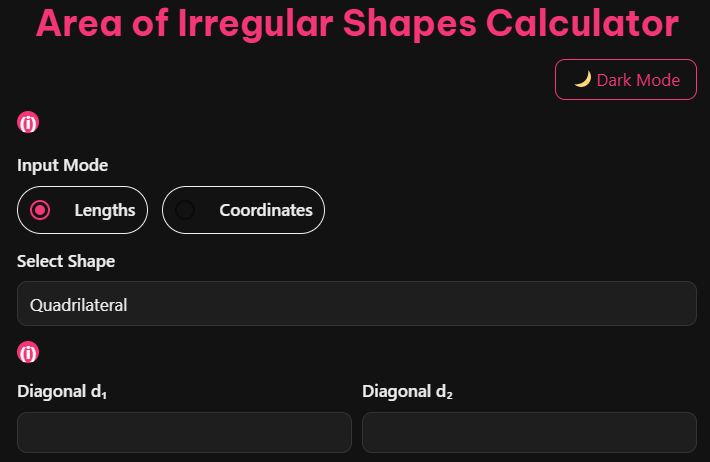Area of Irregular Shapes Calculator
Quadrilaterals: Preferred: A = ½·d₁·d₂·sin(θ) (θ is angle between diagonals).
Fallback (assumes cyclic): Brahmagupta: A = √[(s−a)(s−b)(s−c)(s−d)], s=(a+b+c+d)/2.
n-gon Regular Approx. (Length Mode, n≥5): A = n·s² / [4·tan(π/n)].
Coordinates Mode (3–10 sides): Shoelace: A = ½·|Σ(xᵢyᵢ₊₁ − xᵢ₊₁yᵢ)|.
Calculating the area of irregular shapes can be frustrating when traditional geometry formulas fall short. Whether you’re working with uneven land plots, unique architectural designs, or custom swimming pool layouts, determining accurate area measurements requires specialized tools and techniques.
Understanding Irregular Shapes and Their Complexity
Irregular shapes are polygons with sides of varying lengths and angles that don’t conform to standard geometric patterns. Unlike regular shapes such as squares or circles, these complex forms require sophisticated mathematical approaches to determine their area accurately.
Traditional area calculation methods often involve breaking down irregular shapes into simpler components like triangles or rectangles. However, this manual process proves time-consuming and prone to errors, especially when dealing with shapes containing multiple vertices or curved elements.
Consider these common examples of irregular shapes:
- A plot of land with uneven borders in a rural area
- The outline of a lake or pond on a nature reserve
- The shape of a custom-built swimming pool
- A uniquely designed architectural element in a modern building
- A piece of fabric cut for a custom clothing design
Each of these examples presents unique measurement challenges that benefit from specialized calculation tools.
Introducing our Free Area of Irregular Shapes Calculator 2025

Our Calculator addresses the content gaps found in competitor tools by offering comprehensive features tailored to diverse professional needs. This innovative calculator supports polygons with 3 to 10 sides, utilizing advanced mathematical formulas including Heron’s Formula, Bretschneider’s Formula, and the Shoelace Theorem.
How the Calculator Works
Our Free Calculator employs three primary mathematical approaches depending on the polygon type:
Heron’s Formula handles triangular calculations by using the semi-perimeter method. For a triangle with sides a, b, and c, the formula calculates: Area = √[s(s-a)(s-b)(s-c)], where s represents the semi-perimeter (a+b+c)/2.
Bretschneider’s Formula manages four-sided irregular polygons, accounting for diagonal lengths and varying angles to provide accurate quadrilateral area measurements.
Shoelace Theorem processes complex polygons with 5 to 10 sides using coordinate inputs. This method calculates area by determining the sum of coordinate cross-products, making it ideal for shapes plotted on coordinate systems.
Data input flexibility allows users to enter information as side lengths, coordinates, or diagonal measurements depending on their available information and project requirements.
Step-by-Step Guide to Using the Calculator
Using our Calculator requires just a few simple steps:
Step 1: Select the number of sides for your irregular polygon (3-10 sides supported).
Step 2: Choose your preferred measurement units from the dropdown menu, including meters, feet, inches, or other available options.
Step 3: Input the required measurements. For basic polygons, enter side lengths. For coordinate-based calculations, input vertex coordinates.
Step 4: For quadrilaterals, include diagonal measurements when available to ensure maximum accuracy.
Step 5: Click the “Calculate Area” button to process your inputs.
Step 6: Review the results displayed in multiple units for convenience.
The calculator automatically validates your inputs, alerting you to any measurement inconsistencies that might prevent accurate area calculation.
Benefits of Using the Calculator
Time-saving efficiency eliminates hours spent on complex geometric calculations. What once required multiple formulas and careful computation now takes seconds to complete.
Enhanced accuracy reduces human error through automated mathematical processing. The calculator’s algorithms ensure consistent, reliable results every time.
Mobile accessibility supports fieldwork and remote calculations. The responsive design adapts to smartphones, tablets, and desktop computers seamlessly.
Unit flexibility accommodates various measurement systems without requiring manual conversions.
Applications Across Industries
Real Estate and Land Surveying: Property assessments require accurate area measurements for irregular lots, especially in rural or coastal areas where natural boundaries create unique shapes. Real estate professionals use these calculations for property valuations, tax assessments, and development planning.
Construction and Design: Contractors and architects regularly encounter irregular floor plans, unusual room layouts, and custom building elements. Accurate area calculations inform material estimates, cost projections, and construction timelines.
Educational Purposes: Mathematics educators use the calculator to demonstrate practical geometry applications, helping students understand how theoretical concepts apply to real-world scenarios.
Environmental Studies: Researchers measuring natural features like lake surfaces, forest clearings, or erosion patterns benefit from the calculator’s precision in handling irregular natural shapes.
Manufacturing and Design: Product designers working with custom patterns, fabric layouts, or specialized components use area calculations for material planning and cost optimization.
Tips for Accurate Calculations
Maximize the calculator’s effectiveness with these practical recommendations:
Verify measurement accuracy by double-checking all inputs before calculation. Small measurement errors can significantly impact final results, particularly with larger shapes.
Use consistent units throughout your calculations. Mixing measurement systems within a single calculation increases error potential.
Include diagonal measurements for quadrilaterals when possible. These additional data points improve calculation accuracy, especially for shapes that approach parallelogram configurations.
Consider measurement precision appropriate to your project needs. Construction projects may require millimeter precision, while land surveying might work with foot or meter measurements.
Validate results by comparing with alternative calculation methods when feasible, particularly for critical applications where accuracy is paramount.
Simplify Calculations with Our Tool
Our Calculator represents a significant advancement in geometric calculation tools. By combining mathematical precision with user-friendly design, this calculator addresses real-world measurement challenges across multiple industries and applications.
Experience the difference that advanced calculation technology can make in your work. Try our Calculator today and discover why professionals across industries choose our tool for their most challenging measurement tasks.